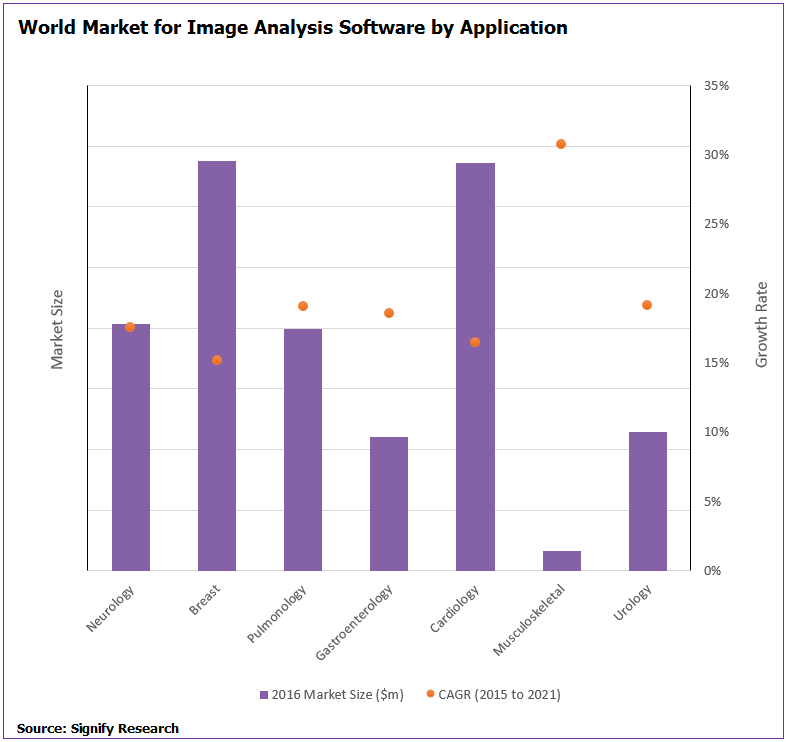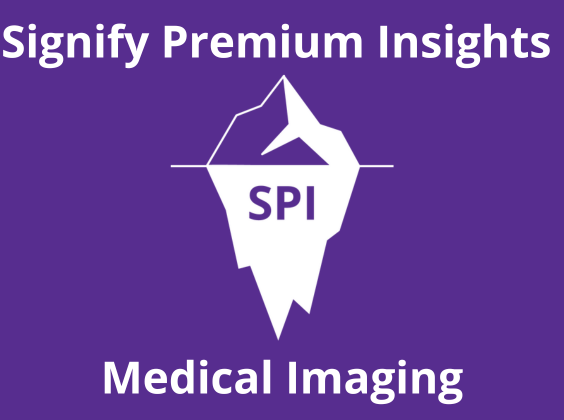
Written by

Rapid advancements in machine learning, most notably deep learning techniques, are fuelling renewed growth for medical image analysis software tools. We estimate that the global market1 for these products will be worth nearly $300 million this year and will more than double in size by 2021. But which clinical applications are driving this growth?

Breast is Best
Breast imaging was the largest category in 2016, accounting for just over one-quarter of the total market. The breast imaging market mainly comprises computer-aided detection (CADe) solutions, such as iCAD’s SecondLook and Hologic’s ImageChecker, for the US breast cancer screening market, along with quantitative image analysis software for diagnosis applications, such as Invivo’s DynaCAD Breast and QLAB Suite from Philips Healthcare.
The market for image analysis tools in breast imaging is forecast to grow at a slower rate than the other applications, as the well-established CADe market in the US is now saturated. The main growth drivers will be:
- CADe upgrades as imaging centres replace 2D mammography systems with digital breast tomosynthesis
- Wider acceptance of CADe outside of the US
- The increasing use of ultrasound (with CADe) in breast cancer screening
- Uptake of new solutions such as breast density analysis software and decision support tools (e.g. MammoRisk from Statlife)
Cardiology Still Pumping
The cardiology market for image analysis software solely comprises quantitative imaging tools2, which are typically sold as applications for advanced visualisation platforms. These tools provide automatic calculation of various cardiovascular metrics, such as stroke volume, ejection fraction and arterial calcification. Growth will be driven by an accelerated pace of innovation from the use of deep learning algorithms and the resulting introduction of innovative solutions that address unmet market needs. In the mid-term, growth will be boosted by the introduction of decision support tools that provide predictive analytics for risk stratification and computer-aided diagnosis (CADx) systems that facilitate early detection of cardiovascular disease. For example, healthbit’s heartcare‚Ñ¢ uses machine learning algorithms to predict congestive heart failure based on cardiac MRI scans.
Deep Breathing
Lung cancer is the leading cause of cancer-related death worldwide, and in response, many countries have introduced lung cancer screening programmes. This is driving demand for CADe solutions, although a lack of reimbursement prohibits more widespread uptake. Early generation CADe solutions based on shallow machine learning suffered from high false positive rates. Deep learning solutions promise improved detection accuracy, which should increase the usability of lung CADe and accelerate demand.
There is also a sizeable and growing market for quantitative image analysis tools for pulmonology applications, that provide characteristics of abnormalities such as size, texture, location, rate of growth, etc. These imaging biomarkers may be useful for predicting prognosis and therapeutic response. As was the case for breast imaging and cardiology, there is also an emerging market for pulmonology decision support tools that combine quantitative imaging with other patient information to provide a data rich, longitudinal history of the patient’s care. An example is the QIDS platform from HealthMyne.
A Head Start in Neurology
Brain scans are the most common type of MRI procedure and accounted for around one-quarter of the 34 million MRI exams performed in the US last year. There is already an established market for quantitative imaging software in neurology, primarily for tools that provide visualisation and quantification of blood perfusion in the brain. Additional growth will come from research into the use of imaging biomarkers for the diagnosis and management of neurological disorders, such as Alzheimer’s disease, multiple sclerosis and Parkinson’s disease.
Growth will be boosted by the introduction of CADe solutions to detect intracranial haemorrhage (ICH) from head CT scans. vRAD and MedyMatch have developed real-time ICH detection tools and both are expected to fully commercialise their solutions in 2017, pending regulatory approval. Teleradiology companies are expected to be the early adopters, particularly in the US as most CT scans ordered by emergency department are interpreted by teleradiologists.
Best of the Rest
The gastroenterology and urology markets for image analysis software were estimated to be similar in size and are forecast to grow at similar CAGRs over the coming years. The gastroenterology market comprises a mix of quantitative tools for analysis of the colon, pancreas and liver and CADe solutions for the detection of colorectal cancer, the third leading cause of cancer death in the US. Colonoscopy remains the gold standard in colon cancer screening, but CT colonography (CTC) is gaining acceptance. However, a lack of reimbursement (CMS does not pay for the use of CTC in colon screening) has hampered the uptake of CTC. The urology market solely comprises quantitative imaging tools, primarily for prostate analysis.
Footnotes
1 The image analysis software market comprises computer-aided detection (CADe) systems, quantitative image analysis tools, decision support tools and computer-aided diagnosis (CADx) systems. A full list of the products included is available on request.
2 The quantitative image analysis tools category includes all software products that provide automatic quantification of anatomical features, not just those that use machine learning. Products that use other image analysis techniques, such as a statistical model-based approach, are also included.
Related Reports
“Machine Learning in Medical Imaging – 2017 Edition” provides a data-centric and global outlook on the current and projected uptake of machine learning in medical imaging. The report blends primary data collected from in-depth interviews with healthcare professionals and technology vendors, to provide a balanced and objective view of the market. If you would like further information please contact Simon.Harris@signifyresearch.net.
